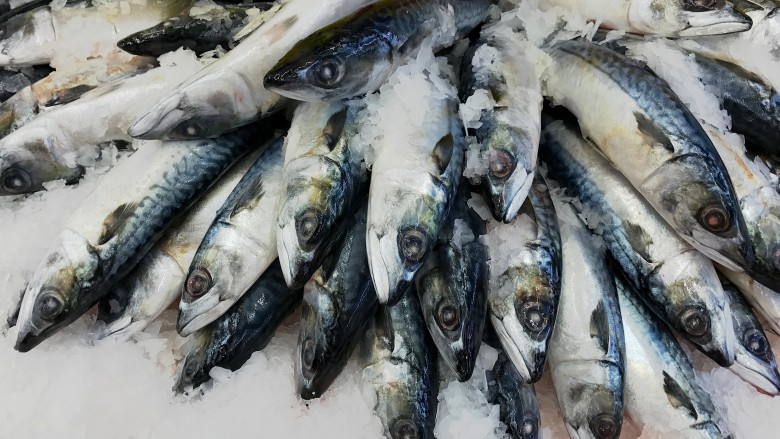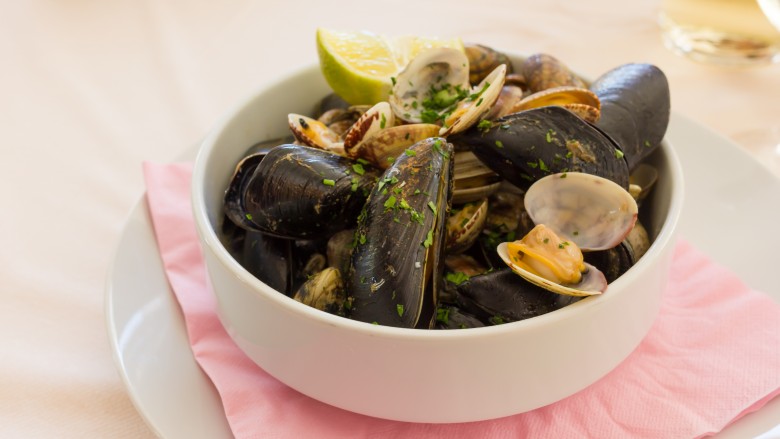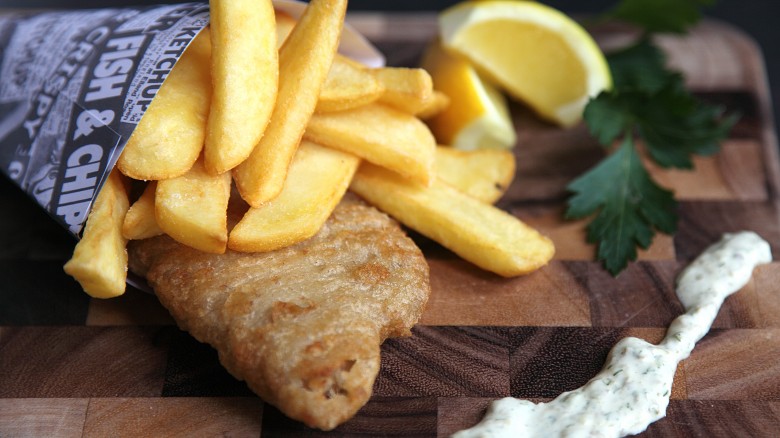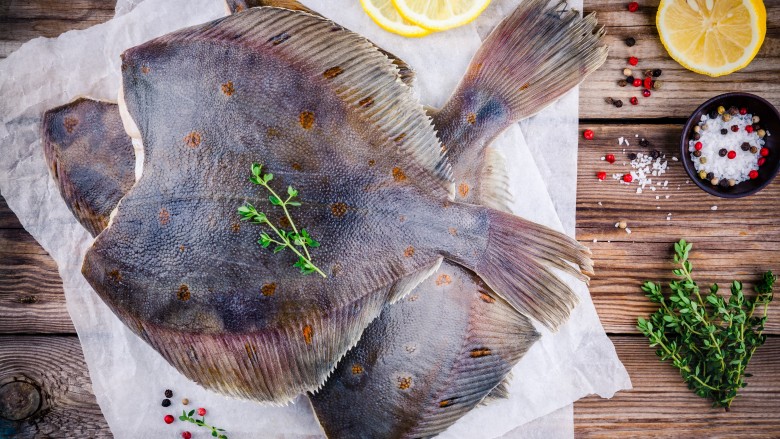Mistakes Everyone Makes When Cooking Fish
Fish and seafood are absolutely delicious when done right — and absolutely disgusting when prepared incorrectly. We all know eating more of the fruits of the sea is great for our health, but too often we get caught up in the fear of messing up what can sometimes be a pricey dinner option. The key to making fish and seafood part of your weekly meal repertoire is knowing how to avoid the most common blunders we've all made when preparing fish at home. What kind of fish should we buy? Where is the best place to get it? Arm yourself with a little bit of fish-cooking knowledge, and you'll be confident buying and cooking delicious fish options any day of the week.
Buying bad fish
The most dire part of preparing and cooking delicious fish and seafood lies in buying the best quality fish you can. Unfortunately, there is a lot of questionable fish flooding the marketplace. Fish that's been blatantly mislabeled, fish that's endangered, fish that's been injected with fillers, fish that's dangerously high in mercury. Find a fishmonger in your area you can trust, who runs a shop that has an oceany, briny smell, but not offensively "fishy." Ask questions. Where is the fish from? Is it wild? What's freshest today? If buying a whole fish, look for eyes that are bright and clear. Fresh fish will have a light scent, but not a strong odor. Once you've made your selection, arm yourself with a plan for the proper method of cooking the fish you chose.
Storing fish
So you've come home from the store after buying the freshest fish you could possibly find...now what? Ideally, you would cook your fish that very day, keeping it as cold as possible until you're ready to prep and cook it. My fishmonger wraps my fish in plastic, and places it in an additional plastic bag filled with ice. If I plan to cook with it that day, I leave it in the fridge this way until I am ready for it. Unlike colder commercial fridges, home refrigerators only get down to about 40 degrees Fahrenheit, which is not a cold enough temperature to keep your fish at its peak of freshness for multiple days. If you won't be cooking your fish for a day or two, wrap the fish in plastic or parchment paper, and set on a bowl of ice in your fridge. You never want to set cut fish fillets or steaks directly in a bowl of ice water, as the excessive moisture will break down the fish. The idea is to keep it very cold, and a bit moist, but never completely wet.
Salmon
You've already made the incredibly smart decision to enjoy some heart and brain healthy wild salmon, so don't ruin your plan by cooking it incorrectly. For starters, whether you prefer to eat the skin or not, make sure to leave it on during the cooking process. Cook the salmon skin side up if you plan to remove it, or skin side down to develop a deliciously crisped treat. Either way, the skin will help to seal in flavor and precious juices. Next, don't season or marinade the salmon too early. Even a hearty fish like salmon is still too delicate for a long seasoning in salt and/or acids, which can begin the curing process. So unless you plan on making homemade lox, skip the seasoning until right before you're ready to cook.
Lastly, be sure to not overcook your salmon, aiming for a temperature similar to how you may enjoy your red meat steaks. A well-done piece of salmon will be dry and rubbery. Experiment with your salmon to see what temperature suits your own tastes, with a "medium" piece of salmon being just cooked through but still juicy. If you're relying on a meat thermometer, aim for 145 degrees Fahrenheit, and allow your salmon to rest a few moments before serving.
Scallops
A popular way to prepare scallops is to sear them. Seared scallops can be a quick and easy weeknight supper, or elevated for special occasions with the addition of a sauce and perfect side dish. But too many people make grievous errors when attempting to sear scallops, and the first mistake is in which scallops they buy in the first place. Wet scallops, the kind often available in your grocer's fish case, are treated with a chemical preservative called sodium tripolyphosphate. The STP causes the scallop to soak up liquid, which the fishmonger likely appreciates since he's selling them by weight. If you attempt to get a nice sear on a wet scallop, you will more than likely end up with a rubbery, chewy, unpleasant morsel. Dry scallops, on the other hand, while pricier, have not been treated with STP, so go to a reputable fish seller and ask about the scallops you plan to purchase. Once you're home with your bundle, sprinkle them liberally with salt and set them on a paper towel to really expel any natural moisture. Then, heat a pan with a high heat point oil until it's blindingly hot, and add the scallops to the pan (don't crowd them!), allowing them to develop a lovely, caramelized crust. Don't move them or flip them until that crust has developed. Give them just a few moments on the other side, and you're done.
Shrimp
If it's possible, secure yourself some wild-caught, fresh shrimp. If it's a choice between fresh, farmed shrimp, or frozen, wild shrimp, I would always go with the wild choice, because farmed shrimp is just gross. Size is indeed important, so skip the mini-shrimp, unless you just want to add it to a soup. In the US, shrimp is sold by the count per pound, so a shrimp listed as 16/20 means you get between 16 and 20 pieces in one pound, with designations all the way from extra small to extra colossal.
To clean your shrimp, remove the shell, the tail if you aren't cooking with it, and the vein that runs down the shrimp's back. This video shows how to take care of it easy-peasy. When I'm cooking a large amount of shrimp, I'm happy to pay the fishmonger an extra buck per pound to do this part for me, though the removed tails and shells are nice to have on hand if you'd like to make a homemade fish stock. Be sure to season your shrimp, and then be extra sure to not overcook it. Shrimp cooks up super-quickly whether you are boiling, pan-frying, or grilling it, so keep an eye on how it's curling up. After just a few minutes it should have curled into a nice C-shape that indicates it's ready to enjoy.
Tuna
Yes, you can cook with canned tuna, but let's assume the tuna errors you're likely making are when dealing with tuna steak. First, skip the pricey Pacific bluefin tuna, which is dangerously close to extinction, and opt for yellowfin tuna, which is also known as ahi. It should be easy to find at the market, and has a pale pink color with a flavor similar to bluefin.
Tuna, unlike a lot of other fish, can stand up well to pre-seasoning, so go ahead and season or even marinade it for an hour or two before you cook it. Like with salmon, tuna steaks are at their flavorful best when not overcooked. If you have very fresh, high-quality tuna, you may enjoy just a quick sear in a very hot pan, leaving you with a very rare, sushi-like center. If you prefer your tuna to be more cooked through, cook it until it begins to flake, but is still pink in the center. The grill or a saute pan are the ideal vessels for cooking a tuna steak, but they will also do well when roasted in a 450-degree oven. My favorite tuna steak recipe pairs it with avocado and cilantro lime dressing.
Clams and mussels
Buying canned clams or mussels is an economical and simple choice, but they're not going to give you the same satisfying flavor as buying fresh, live bivalves. Regardless of how much you love your fishmonger, your shellfish will likely do well from another cleaning when you get home. Take care to scrub any barnacles or fuzzy "beards" from the shells. Clams can benefit from an additional soak in cold, salty water to coax out any remaining sand.
The most common mistake people make when cooking clams and mussels is attempting to boil them, when they should actually be steaming them. Prepare a very flavorful cooking liquid using aromatic herbs, fish stock, beer, or wine. Throw them into the hot pan, careful not to overcrowd them, and cover tightly for about five minutes, giving the pan a good shake every now and then. Open the pan and — this part is extremely important — dispose of any that didn't open up. Those clams or mussels were dead when you bought them, and are unsafe to eat.
Cod, pollock, and haddock
Cod, pollock, and haddock... can you guess what these three different types of fish have in common? Cod, pollock, and haddock bear the distinction of being the most popular choices of fish for making fish and chips. While true fish and chip aficionados may have their preferences, you're likely to enjoy any of these fish interchangeably in your fish and chips, though you may want to avoid Atlantic cod as it's highly endangered.
The biggest mistake people make when cooking homemade fish and chips is not getting the batter right. An authentic fish and chip batter is made with beer, making a batter similar to a tempura. It's also very important to dredge the fish fillets in some flour before dipping into the batter, or it will not cling evenly. Your cooking oil should be no lower than 320 degrees Fahrenheit, and as high as 375 degrees, depending on your choice of cooking oil, so a frying thermometer is key to getting this dish just right. Serve with plenty of lemon and tartar sauce, and the Brits' favorite side dish — mushy peas.
Catfish
I ate my fair share of fried catfish when I lived down South. While I have experimented with baking catfish in the oven or sauteing it in a frying pan, I know nothing can match the deliciousness of a true, Southern-style fried catfish. There are really only a few simple rules to follow. Cut the catfish fillets down into manageable pieces, and make sure you make a really good batter. The classic recipe calls for cornmeal, along with a leavening agent like baking soda, which allows for an amazingly crispy crust. Double dip the batter, using an egg wash, to achieve the crispiest results. Deep fry the fillets at a temp of at least 350 degrees Fahrenheit, and cook until they're golden brown and float to the top. My favorite combo would be served with hush puppies and collard greens.
Flatfish
The term flatfish refers to a group of fish you're likely very familiar with, the most common being flounder, sole, and halibut. With light, flaky, mild-flavored flesh, flatfish have similar cooking times and preparations, so you can typically sub one for the other in your favorite recipes. Their low oil and calorie content also make flatfish a favorite among dieters. The delicate flavor of flatfish mean you have to be sure to season them, but not overpower them with too many bold ingredients. Try baking them in the oven with some fresh herbs, or try my favorite preparation, pan-frying in a quick and easy lemon butter sauce.
Lobster
OK, I get that cooking lobster can be intimidating, but it shouldn't be! As long as you know which lobster mistakes to avoid, you can easily become a lobster-cooking pro. First, make sure you buy fresh, live lobsters. One person can easily throw back a one and a half pound lobster themselves, as it will only yield about six ounces or so of meat. Getting the cooking time right with lobsters is very important, as an under-cooked lobster won't easily release its meat, while overcooked lobster will be way too chewy.
Whole lobsters can be boiled or steamed in a large pot of salty water (just like the ocean!). Summer lobsters cook at about seven minutes per pound if boiling, and a minute longer if steaming. Winter lobsters have harder shells, and require a bit more time. Make sure not to overcrowd your pot. Your lobsters are done when they are bright red all over, and an antenna easily removes when tugged.










